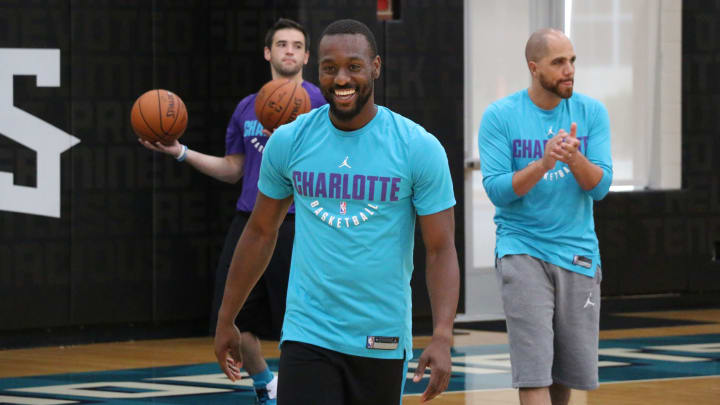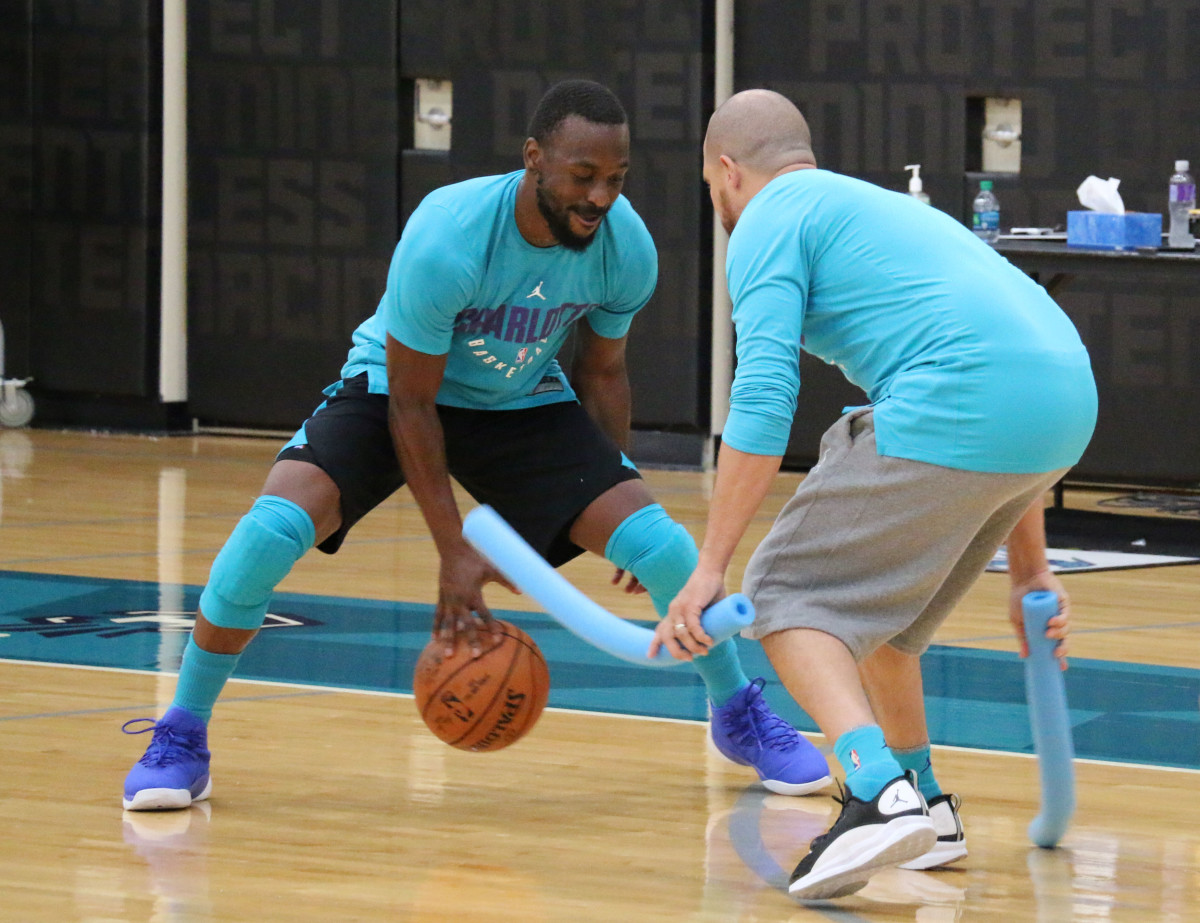The Man Behind Kemba Walker's Rise to Point Guard Royalty

A miniature Kemba Walker streaks across the monitor, yo-yoing around high ball screen after high ball screen. With each clip, the All-Star point guard ultimately gets clogged by the defense, waiting for his big man to roll towards the rim. If Walker can pounce the moment the opposing giant turns to track his teammate, and directly follow that big man’s line, a sea of defense would part and open space for Walker’s devastating dribble drives. The film pauses. “You might be able to get some money out of that,” says Jay Hernandez, a Charlotte Hornets assistant coach.
The real Walker nods along, sitting left of Hernandez on a bench inside the NBPA’s practice court, five stories above New York City’s Bryant Park. It’s Aug. 15 and Walker is two days removed from a lengthy trip to China. His body is still jet-lagged, his stomach still unsettled from pounds of fast food devoured while dodging the country’s surplus of raw fish. It feels like months since Walker last touched a basketball in competition, and it’s been even longer since he and Hernandez collaborated on hardwood.
For Philadelphia and Markelle Fultz, the Future Must Begin Now
The duo first trained together in the summer of 2009, when Walker was merely a rising sophomore at UConn. After spending his freshman season as senior guard A.J. Price's understudy, he faced a giant uptick in playing time and ball-handling responsibilities. At the recommendation of then-Huskies assistant Andre LeFleur, Walker and Hernandez met in a nondescript Manhattan gym. Walker arrived coachable—unlike most brash New York City guards—and eager to harbor Hernandez’s teachings. He would start all 34 of UConn’s 2009–10 games, exploding for 14.6 points, 5.1 assists and 4.3 rebounds per game. Fast-forward two summers, fresh off claiming the 2011 national championship, Walker signed with Excel Sports in advance of the NBA draft, and the agency guided Walker, along with their other clients, to train with Hernandez in Long Island, N.Y., leading up to the pre-draft process.
Hernandez was more guru than professional trainer. He bunked players in the same apartment complex, instructed them how to balance a proper diet and infused deliberate skill work within a jovial environment. Walker had already blossomed into Kardiac Kemba, delivering myriad step-back, game-winning daggers throughout the Huskies’ magical postseason run. NBA schemes, though, would present countless pick-and-roll opportunities, decreasing solo isolations and requiring Walker to undergo a total makeover. The way he now slithers through trapping defenders out of high-screen actions, dancing past help en route to the tin, Walker learned from Hernandez. Those sessions marked the first time Walker whipped his killer crossover underneath 12-inch agility hurdles. “A lot of my moves I do before the pick and roll to set my man up, a lot of those moves to get my man leaning one way, a lot of that stuff’s from Jay,” Walker says. “I do all those crazy split the ball screens, a lot of that is from Jay.”

Teaching runs in Hernandez’s blood. After playing 13 years professionally in Puerto Rico, his father Rich coached AAU and trained kids on the side while maintaining jobs in air freight and shipping. While Hernandez played alongside Speedy Claxton and Norm Richardson at Jay Wright’s Hofstra program in 1998–01, he was working out high schoolers in between classes and practice. Marrying his high school sweetheart forced Hernandez to embrace an entrepreneurial spirit and he earned a dual MBA in marketing management just as the Pride reached the NCAA Tournament in 2001.
Hernandez landed a job in pharmaceutical sales directly out of college, streamlining whatever funds his family could afford into his budding basketball training company. After two years, Hernandez quit his day job, forfeiting the company car and compensated gas money. He played one more summer professionally in Puerto Rico in 2004, generating enough money for his family to survive the first six months of exclusively running basketball camps. “When people asked me what I did for a living, I wanted to tell them I own my own basketball business,” Hernandez says. “I wanted people to know, at a drop of a dime, I can go to Philly to train Jameer Nelson, I can take time off and do a camp.”
Wally Szczerbiak emerged as Hernandez’s first professional client back in 2001. They had played against each other in Long Island high school ball, competed in the same summer pick-up runs, and teamed in several semi-pro offseason leagues. Szczerbiak knew Hernandez’s long history of training when the two-year NBA veteran laced up his sneakers and hopped in line one evening during Hernandez’s high school girls group session. Szczerbiak didn’t care who was in the gym, so long as they were drilling pull-up jumpers and dribble combinations. After each session, Hernandez would help him analyze film on VHS tapes and CDs. “He gave me a great credit of helping him become an NBA All-Star,” Hernandez said. “That helped pave the way for the program.” The following season, Szczerbiak earned those honors posting 18.7 points on 45.5% shooting from deep for Minnesota.
The Upstart Pacers Are Grounded in Restraint
Hernandez’s training naturally manifested during the NBA pre-draft process. He himself had bounced around the periphery of professional basketball, fully grasping the challenges of putting food on the table based on that orange ball. He understood that hooping morphs into job interviews and players become a walking resume after departing college.
“It’s the first time it’s not a team sport. You’re out their making your money,” Hernandez says. “You’re literally going to a team workout as Kemba Walker, not representing your team or your coach, trying to claw your way to be a high lottery pick.” After working out players three times a day, Hernandez would often include Muay Thai sessions to instill a fighter’s mentality, while also incorporating footwork, cardio, diverse movements and reaction timing. “He’s pretty unorthodox sometimes,” Walker says.
Tobias Harris joined Walker during that 2011 pre-draft process. Like many of Hernandez’s players, both he and Walker returned to Long Island for offseason workouts as young pros. By the time Harris fully bloomed in Orlando, head coach Jacque Vaughn was putting together a revamped Magic staff for the upcoming 2014–15 season. Vaughn had heard enough word about the dynamic skills trainer in New York and sought a development staffer who could relate to players. Orlando hired Hernandez that fall, and Harris’s gain became Walker’s loss. “Then we weren’t allowed to work together,” Walker says. “I was pissed.”

Four years and four Magic head coaches later, Hernandez has departed Orlando to join James Borrego’s staff in Charlotte. Walker learned early of Borrego’s intentions to add his old trainer and anxiously pestered the Hornets’ new head coach. “I was always texting him like, 'Did we get him yet? Did we get him yet?'” Walker says. “We had to get him.”
Now reunited in purple and teal, Walker and Hernandez met at the Player’s Association for the better part of the week, nine years after they initially joined forces in the same city. “We have a special connection,” Walker says. “His workouts are just amazing. A lot of these workout guys, the new guys I see on social media, he’s been doing that. He can actually do the stuff he’s teaching. He’s unbelievable at this stuff. He’ll do the move, boom, boom, boom, perfect, and make the shot. He played, he knows, he understands. I got a lot of respect for that man. I gotta give him a lot of credit for a lot of my success as well.”
When LeBron Joined the Lakers, Everything Changed for Brandon Ingram
After Hernandez breaks down some of Walker’s pick-and-roll shortcomings, he fires up footage of Charlotte’s 2017–18 games against Philadelphia. Hernandez freezes the film often to note the Hornets’ suboptimal spacing, as multiple wings are stationed at the break in the three-point line when Walker looks to operate at the top of the key. Hernandez says Borrego, a fellow former Magic assistant, will instruct their players to instead be positioned along the baseline. “That’s gonna be on you, too,” Hernandez explains. “You gotta be on guys, ‘Get to the f----ing corner!’” As an example, the next clip Hernandez shows features Sixers guard Ben Simmons leaving his assignment to clamp down on Walker’s drive. “He’s not gonna be able to do this this year,” Hernandez says. One of the league’s premier penetrators, Walker can’t help but grin.
With video study complete, the longtime duo wades onto the court. They begin inches from the basket, Walker flicking the ball high above the rim before it swishes through. He steps back to the dotted line in the middle of the key, hoisting stationary shots. He retreats further to the foul line, where he and Hernandez pass the ball nine consecutive times—but through his shooting motion, not like a chest pass—until Walker lofts a free throw instead of starting the 10th pass. That bleeds into dribble combos and pull-up jumpers at each elbow. Walker next gravitates out to each wing, drilling his patented step-back and exploding into floaters and up-and-unders around the basket.
It’s on to shooting. Hernandez directs Walker to the right corner, where he will shoot five different shots and cannot advance to the next location on the floor before draining all five unique looks in a row. First comes a catch-and-shoot midrange jumper, then a pull-up midrange shot, a catch-and-shoot triple, a three after running the baseline and turning out, and then head-faking a defender into flying past a catch-and-shoot look. His overseas journey still weighing on him, the Hornets star shouts “Come on, Walk!” after misses. Hernandez rotates Walker around the perimeter, with similar five-shot sequences, sometimes mimicking rotations to space teammates’ drives or including another dribble in each scenario.
About 20 minutes later, Walker completes the lengthy drill, his travel rust finally starting to wear off. Hernandez jogs over to the sideline and grabs a hurdle. Walker’s utilized the device in training throughout his career, but now positioned on the right wing, Hernandez wants his point guard to cross over right-to-left through the hurdle, then sequentially scoop the hurdle with his right hand as his left pounds the rock. After two power dribbles to the elbow, Hernandez has Walker replace the hurdle onto the hardwood, lurch back to freeze a mock-help defender, and also then fire an in-and-out dribble into a bounce back through the hurdle. Once Walker slips the ball under the hurdle a second time, he can then finish at the basket with any floater or nifty layup he wishes. It’s a thorny drill. Walker’s dribble crashes into the hurdle on multiple occasions. Eventually he gets the rhythm down, and realizes just how low he needs to get to master the challenge of each literal hurdle, which will only help him snake past defenders this season.
All the while, Game 3 of the Hornets-Knicks 1993 Eastern Conference semifinals coincidentally streams on the massive TVs above the court. It just so happens to be Hornets Day on NBA TV. “If this isn’t motivation…” Hernandez smiles. “We haven’t been to the second round of the playoffs in over 10 years.” As LeBron migrates West, the Hornets are indeed one of the East teams hoping to resurface in the postseason. Nic Batum is finally healthy. Malik Monk may be poised for a breakout sophomore year. Lottery pick Miles Bridges could add to Charlotte’s intriguing depth. Most importantly, Walker returns following a season of trade speculation, his most-trusted coaching ally in tow.
